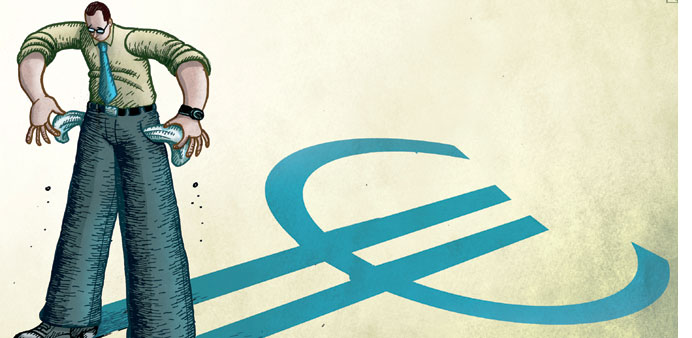|
The European Commission’s latest economic outlook paints a disheartening picture: unemployment rates close to or above 5% in Austria, Germany, and the Netherlands in 2014, but above 25% in Greece and Spain and roughly 15% in Ireland and Portugal. |
In the same year, per capita GDP is expected to be almost 7% above its pre-crisis level in Germany, but about 7% below in Ireland, Portugal, and Spain – and a terrifying 24% below in Greece. So the deep economic and social divide that has emerged within the eurozone is expected to persist.
Such a gulf within a monetary union cannot be sustained for very long. As Abraham Lincoln said, “a house divided against itself cannot stand.” The same monetary policy cannot possibly fit the needs of a country that is in depression and another that is at or close to full employment.
Indeed, the single most important question for the future of the eurozone is whether the gap between prospering and struggling members is being closed.
The optimistic reading is that, despite no sign of improvement in the labour market, economic performance has in fact started to improve, and an adjustment process is under way. The proof, it is often argued, is that external deficits have contracted substantially.
External accounts clearly matter, because they reflect the balance between domestic saving and investment. Until 2007, imbalances within the eurozone largely resulted from too little saving and/or too much real-estate investment, resulting in a growing accumulation of private debt.
So the contraction of external deficits is a sign that a correction is under way, and the rebalancing is impressive. In Spain, Portugal, and Greece, the deficit has been reduced by more than seven percentage points of GDP since 2007, and in Ireland the current-account balance has swung into surplus.
The problem, however, is that a large part of this improvement reflects collapsing domestic demand, which has plummeted by around one-quarter in Greece and Ireland since 2007, and by one-eighth in Spain and Portugal. Investment in equipment – the key to strengthening productive capital in the tradable-goods sector – has generally suffered even more.
To be sure, demand contraction was inevitable in these countries, given that they were living far beyond their means; no economy can permanently sustain a rate of demand growth exceeding that of GDP. But what we have seen since 2007 is an overshooting of the contraction in consumer demand and domestic investment. This cannot be regarded as a success.
The news is better on the export side. Despite a grim environment, exports/GDP ratios have increased significantly in all four economies.
Ireland was known to be a very reactive, outward-oriented economy. But it’s not only Ireland. Confronted with domestic economic collapse and a stagnant European environment, firms in Greece, Spain, and Portugal have turned to overseas markets and significantly increased their countries’ shares of eurozone exports to the rest of the world.
Spain’s performance in foreign markets is especially impressive. On the eve of the euro’s creation, its exports outside the EU were just a quarter of French non-EU exports; now they are half the French level.
The question, to which a clear answer may be impossible, is how much of these exports are for profit and how much are for survival – and thus whether strong trade performance can be sustained. This brings us to the issue of price and cost adjustment.
During the euro’s first decade, the countries that are now struggling recorded persistently higher wage and price inflation than those in Europe’s north. To recover and return to both internal and external balance, they must not only close the cost gap, but actually reverse it, thereby generating the trade surpluses needed to repay the foreign debt that they accumulated in the meantime.
The news on this front is mixed. Since 2007, labour costs have roughly stagnated in Greece, Spain, and Portugal (though the mix of wage cuts and productivity gains varies from country to country), and have contracted by 8% in Ireland, whereas they have increased by more than 10% in Germany. So a rebalancing is under way.
Contrary to stereotypes, for example, real wages in Greece have declined by 6% annually over the last three years. The problem, however, is that prices have generally proved much more rigid, declining only in Ireland. In the rest of struggling Europe, price adjustment is barely noticeable. Firms, especially in sectors sheltered from international competition, have retained market power and have increased prices in response to the rising cost of capital.
The result is that the process of internal devaluation, as economists call it, is occurring very slowly. Employees have suffered wage cuts, but prices have not declined accordingly, so their loss of purchasing power is higher than it should be. Likewise, economies have not recovered lost competitiveness, so employment, especially in the traded-goods sector, is lower than it should be.
Austerity and reforms were supposed to deliver rebalancing within the eurozone. And so they have, at least insofar as external balances are concerned. But, despite visible progress on the export front and noticeable labour-cost reductions, this rebalancing is mostly the result of the same collapse in domestic demand that is driving mass unemployment.
Ultimately, perhaps, all the pain will pay off. But societies may lose patience in the meantime. This should be enough to prompt a reassessment. The issue is not whether fiscal consolidation and external rebalancing are necessary – they are. It is how to make them politically and socially sustainable. - Project Syndicate
♦ Jean Pisani-Ferry is director of Bruegel, an international economics think tank, professor of economics at UniversiteParis-Dauphine, and a member of the French prime minister’s Council of Economic Analysis.

